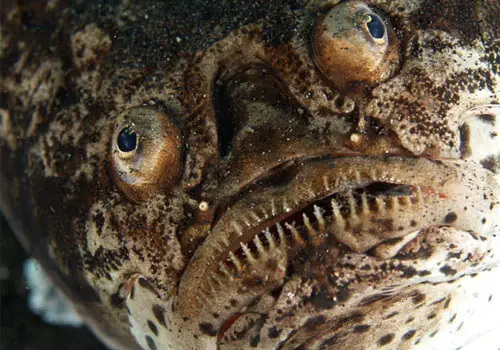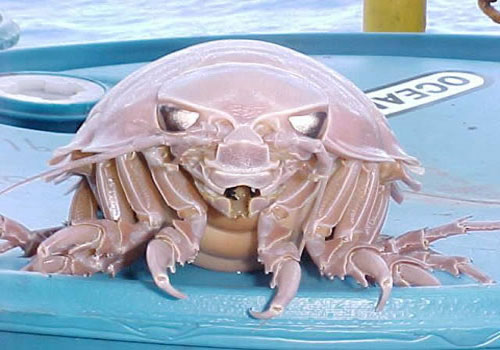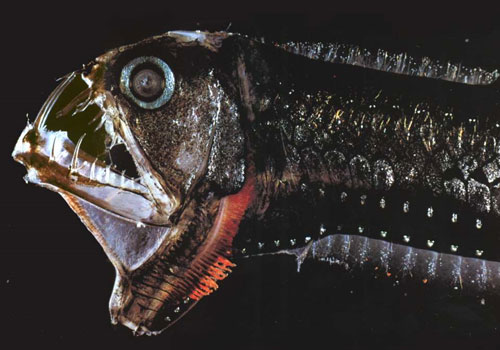April 30, 2010
22 Sea Creatures That Will Keep You Dry
Here’s something to keep in mind the next time you find yourself fancying a quick swim to cool down after a hot day on the beach… 22 sea creatures that are lurking below, sharing the same waters. Keep our advice… If it’s not chlorine, stay well away!
#22 The Stargazer

The stargazers are a family Uranoscopidae of perciform fish that have eyes on top of their heads (hense the name).
#21 The Lizard Fish

The Lizardfishes are a family, the Synodontidae, of aulopiform fish. They are found in tropical and subtropical marine waters throughout the world.
#20 The Fimbriated Moray Eel

The fimbriated moray eel is of the family Muraenidae, found in the Indo-Pacific oceans, around reefs, harbours and small caves, at depths down to 45 meters.
#19 The Giant Isopod

Related to both shrimp and crabs, Giant Isopods are found deep in the cold Atlantic waters.
#18 The Viperfish

A viperfish is a deepwater fish in the genus Chauliodus, with long, needle-like teeth and hinged lower jaws. They grow to lengths of 30 to 60 cm (12 - 24 inches).
#17 The Giant Squid

Giant squids can grow to an incredible size; estimates put the maximum size at 13 metres for females and 10 metres for males.
#16 The Saccopharyngiformes (Gulper Eel)

Due to the gulper eel's specialised body shape, it is a poor swimmer and relies on the luminescent organ at the tip of its tail to attract prey.
#15 The Angler Fish

Anglers are bony fish named for their characteristic mode of predation, wherein a fleshy growth from the fish's head acts as a lure; this is considered analogous to angling.
#14 The Barreleye

Barreleyes are also known as the spook fish, they are small, unusual-looking deep-sea osmeriform fish comprising the family Opisthoproctidae. Found in tropical waters of the Atlantic, Pacific, and Indian Oceans
#13 The Coffinfish

Coffinfish are bottom-dwelling fishes found on the continental slopes of the Atlantic, Indian and Pacific Oceans, at depths of up to 2,000 metres (6,600 ft).
#12 The Wolffish

"A face not even a mother could love" The Atlantic Wolffish, also known as the Seawolf, Atlantic catfish, ocean catfish, wolf eel, or sea cat, is a marine fish, the largest of the wolffish family Anarhichadidae.
#11 The Chimaera Fish

Chimaeras are cartilaginous fish in the order Chimaeriformes, known informally as ghost sharks. They may be the oldest and most enigmatic groups of fishes alive today.
#10 The Axolotl

The axolotl is the best known of the Mexican neotenic mole salamanders. Larvae of this species fail to undergo metamorphosis, so the adults remain aquatic and gilled. Axolotls are used extensively in scientific research due to their ability to regenerate most body parts.
#9 The Lumpfish

Living up to its name, the lumpfish has scaleless skin with a bumpy ridge down its back (which is actually a modification of the first dorsal fin) and rows of knobby protuberances, called tubercles, down each side.
#8 The Vampire Squid

The Vampire Squid, or Vampyroteuthis infernalis (which literally translates as “vampire squid from hell”), is another inhabitant of the deep sea, usually found in temperate and tropical oceans and was actually incorrectly identified as an octopus when it was first spotted.
#7 The Hagfish

Hagfish have elongated, eel-like bodies (so flexible they sometimes tie themselves in knots). They have four hearts, two brains, and a paddle-like tail.
#6 The Fangtooth

Fangtooths are deep-sea, ferocious-looking beryciform fish of the family Anoplogastridae. Found in the tropical waters of the Pacific and Atlantic Ocean.
#5 The Lamprey

A lamprey is a parasitic marine/aquatic animal with a toothed, funnel-like sucking mouth. Translated directly, their name means stone lickers.
#4 The Sperm Whale

The sperm whale is a marine mammal species, order Cetacea, a toothed whale having the largest brain of any animal.
#3 The Frilled Shark

The frilled shark is one of the two extant species of shark in the family Chlamydoselachidae. This uncommon species is found over the outer continental shelf and upper continental slope, generally near the bottom though there is evidence of substantial upward movements.
#2 The Piglet Squid

The Piglet Squid, Helicocranchia pfefferi, is about the size of an orange, it was named because of its tuft of bristle-like arms and tentacles and rotund shape, is normally found more than 320 feet (100m) below the surface of the ocean.
#1 Great White Shark

The great white shark, also known as white death, is a large lamniform shark found in coastal surface waters in ALL major oceans. It becomes sexually mature at around 15 years of age and has a lifespan of 30 to over 100 years. It's arguably the world's largest known predatory fish and is the only surviving species of its genus, Carcharodon.
31 Comments



the greatest story ever
these pictures and facts are awesome, but they freaked me out!
The Axolotl looks so human-like with the fingers and the face and eyes…the info was amazing and the pictures too!!
Our nature is so beautifulle .. the pictures is amazing!!!
The majority of the things on this list, IN NO WAY, pose a threat to humans.
Haha very true! As a majority of them are deep sea creatures- humans in no way come in contact with the deep sea.
the pictures looks great …
these pics totally give me the creeps! half my family calls them the possesed pics!
creepy thats all i can say
wow your scared wow im not even scared at all.
i couldn’t look at the giant ispod, i just couldn’t its disgusting!!
A frilled shark does not look anything like this when healthy, it looks much more like a normal shark, only somewhat thin, kind of a crossbreed between a shark and a eel, but not that much.
some of these animals creep me out like the angler fish and the stargazer and viper fish the vampire squid and the fang tooth the cute ones is the piglet squid some of them are sick i love animals but not these fish.
angler fish angler fish strangrler
where is the Blobfish?
wow thats ……wow i like the piglet squid agree????
i like the piglet squid,, its so cute,,,,,,
i like the piglet squid,, its so cute,,,,,,
I had 2 axolotls once, they were smiling and cuter than looking at a picture of one!
Go see the monsterus jackfruit. The jackfuit taste like shit & smell ass .
you missed megalodon even though somesay it”s a myth or it’s to be extinct you never know what lies in the bottoms of the waters
Its not a myth, its a real shark that existed before humans. Its gone extinct.
holy shit
is it just me or did the fangtooth just come from his daily fishslaughter? creeeeepyyyy………….que chevere! orale, ahora si se puede llamar guerrero del oceano. A la Huelga!
•The [piglet squid looks like a see through piggybank with hair! LOL :P !
•The [piglet squid looks like a see through piggybank with hair! LOL :P !
Mkay who thinks angler fish are sexy? :D
Wow, doesnt that get anyone admiring and thinking about who created all these beautiful creatures?
Wow, doesnt that get anyone admiring and thinking about who created all these beautiful creatures?
those fish are awesome amazing and many more
The lizard fish looks like something out of a Tim Burton movie, like the creature in Beetlejuice.